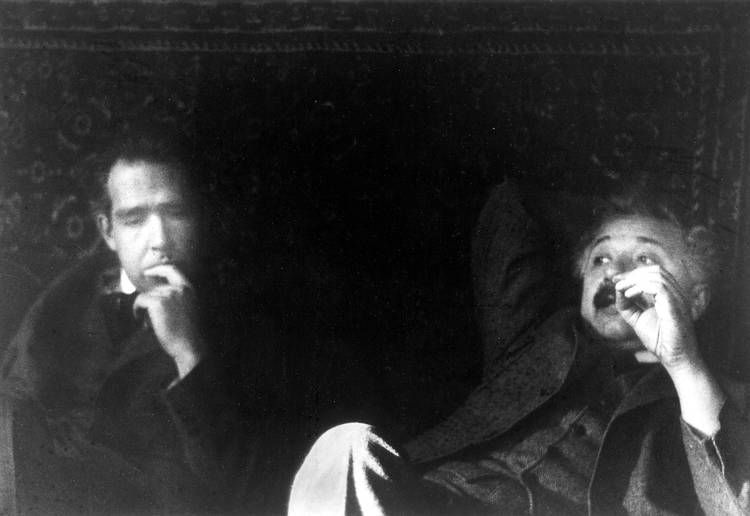
One thing marking the modern age from previous historical periods is the rise of science and technology. Indeed, through science and technology, many things are possible now that would've been viewed as miracles just a few generations ago.
But so worshipful of science has society become these days that it has almost become a new religion in itself. It has its prophets, prophesies, high priests, monasteries of higher learning, miracles, ancient relics, shrines and places of worship. Then there's the blind faith entertained by many scientists that science will one day solve all the world’s problems (omnipotence), and explain everything (omniscience). That faith would be rather endearing if it weren't so scary.
Setting that aside, let’s explore a few examples where there's great synergy between wisdom traditions and science.
Science is one form of knowledge
Science comes from the Latin word "scientia," meaning knowledge. There are many different kinds of knowledge. For example, there's knowledge as a piece of information, like knowing a telephone number or what is the approximate population of a country. Then there's the knowledge about the physical world and its laws, which is what science aims at elucidating and technology aims at mastering. Then there's knowledge as wisdom. A person could know a lot about science and technology but not be wise, compassionate, just or ethical, but a person couldn't be called wise without these qualities.
Etymologically, wisdom is traced back through words like "wis," "wit" and "weid," but originally comes from the Sanskrit word "vid," which is related to words like "veda," and means spiritual knowledge. Wisdom has an enduring quality about it in that it doesn’t change because it's knowledge about things that don’t change. It's metaphysical in that it looks beyond the surface to see what lies behind the physical world and its phenomena. Mostly, science doesn’t do that, as most scientists take a materialist view of the universe. Wisdom is universal and holistic and can be derived from intuition as well as empirical experience. Truly great scientists, like Einstein, were also intuitive.

Albert Einstein (right) with physicist Niels Bohr, 1925
Albert Einstein called the intuitive or metaphoric mind a sacred gift. He added that the rational mind was a faithful servant. It is paradoxical that in the context of modern life we have begun to worship the servant and defile the divine. - Bob Samples, from The Metaphoric Mind: A Celebration of Creative Consciousness
I believe in intuition and inspiration. Imagination is more important than knowledge. For knowledge is limited, whereas imagination embraces the entire world, stimulating progress, giving birth to evolution. It is, strictly speaking, a real factor in scientific research. - Albert Einstein, On Cosmic Religion and Other Opinions and Aphorisms
Science, in the hands of a humble genius like an Einstein, is informed by benevolence and a deep respect for nature. To him, it was a form of worship of the spiritual and a source of awe, inspiration and wisdom.
In the hands of a lesser scientific mind of dubious motivation, limited insight, disdain for nature and puffed-up arrogance, science can be dangerous. It has the potential to put the means of mass destruction—for example, a thermonuclear warhead, agents of chemical or biological warfare—into the hands of people who consciously mean to harm others or who commit harm inadvertently. It also allows people to cross boundaries, in the name of scientific freedom, that nature would normally not cross, like mixing the DNA from different species.
Science and technology, like a gun, are neither good nor bad in themselves, but are good or bad depending on the motivation and insight of the people wielding them. What'll be the motivation behind much science if it unhooks itself from long tried-and-tested ethical and moral codes?
Wisdom and science, when done well, give insights into what lies beneath the surface and both express those insights through their practical application. This chapter will explore some useful insights from science that may inform our understanding of freedom as well as raise questions of concern.
The neuroscience of well-being
In the last chapter we explored a little of what Plato had to say about the make-up of the human psyche and its implications for government, whether of the individual or the society. He must've been a very astute observer of human nature because millennia later, modern neuroscience has come to very similar conclusions as Plato, although now there's more detail and the names for what he described are different.
In broad terms, there are three main regions of the human brain vying for authority. They bear an uncanny resemblance to Plato’s higher (reasoning), middle (emotive) and lower (appetitive) levels of the psyche. They have their own distinct roles, although they all interact with each other. From a neuroscience perspective, these three regions are the:
prefrontal cortex—relating to higher (executive) functions
limbic system—relating to emotions
mesolimbic reward system—relating to appetites and instincts.
The most reasonable, sociable, happy, harmonious, healthy and functioning human being has these three regions well-integrated with each other. Their natural order is the executive functioning centre regulating, not suppressing, the expression of the other two centres. Executive functions include working memory (the ability to hold and process information), decision-making, self-awareness (the ability to observe one’s mind, body and behaviours), self-regulation (the ability to regulate rather than be ruled by emotions), impulse control and appetite regulation. This, on a neurological level, is self-mastery.
The executive functioning area of the brain is far more highly developed in humans than other species, and it's the last area of the brain to fully develop. This happens from late adolescence to early adulthood and occurs more slowly in males than females, which explains a lot about young males, impulsivity and bad behaviour.
Upbringing and environment have a major impact on the development of this vitally important area of the brain. For example, the brains of adolescents brought up in hostile and unsupportive environments, especially males, are predisposed to antisocial behaviours in later life because of overstimulation of the brain’s stress centre (the amygdala—part of the limbic system important for the stress response) and underdevelopment of the prefrontal cortex.
Such people are primed for learning, social, behavioural, physical and mental health problems. An adolescent with excess aggression, particularly a male, has a significantly larger and more reactive amygdala and a less developed prefrontal cortex than those who don't have issues with aggression.
A child may have had a chaotic upbringing but, unless they learn strategies for self-awareness and self-regulation in adolescence or early adulthood, they'll likely find themselves trapped by their own compulsions and emotional reactions later in life, with negative consequences for themselves and those around them. The extent to which this absolves an individual of responsibility for their crimes is vigorously debated. Are we trapped by our neurology, in which case we're not responsible, or are we meant to be masters of our neurology?
 Neuroplasticity—as we think, so we become
Neuroplasticity—as we think, so we becomeOur understanding of the brain has gone through a major revolution in the last two decades. It was long taught that once wired in childhood, the brain didn’t change, apart from losing brain cells as we age. That view sees us as prisoners of our neurology.
Now we know that the brain wires and rewires itself throughout life, so we have more scope for change than previously realized. Every time we think, do, say or respond to something, we activate the corresponding neural pathways, encouraging them to make further connections and to stimulate new brain cell growth (neurogenesis). Circuits that aren’t being used get pruned back.
This is called neuroplasticity and it can work for or against us. When we cultivate useful thoughts, attitudes and behaviours, then they get easier to think and do. The same thing happens with unhelpful thoughts and behaviours. The longer they’re engrained, the harder they are to change. We become constrained by those patterns until they become habits or “second-nature.”
One environment in the home, peer-group or school will bring out one aspect of a child’s behaviour whereas another environment will bring out other aspects.
Some examples of neuroplasticity at work
If we practice compassion through compassion training, it gets easier to be compassionate. Borderline personality disorder is generally thought to be unamenable to change, but just three weeks of loving-kindness and compassion meditation increased acceptance of the present-moment experience and led to significant improvements in the severity of borderline symptoms, self-criticism, mindfulness, acceptance and self-kindness.
In another study, an intensive multifaceted mindfulness-based intervention for young adults led to substantial and enduring improvements across multiple cognitive and neuroimaging measures, like substantial improvements in physical health, working memory, performance, mood, self-esteem, self-efficacy, mindfulness and life satisfaction.
Improvements in mindfulness were associated with changes in the insula, an area of the brain that's very important for regulating appetite, habit and addiction. Improvements were also observed in the executive control network. Furthermore, the precuneus is a brain region that becomes active when experiencing consciousness, wakefulness and self-awareness. It's important for attention, memory retrieval, working memory, conscious perception and visuospatial processing. It's impaired by distraction (default mental activity) and is larger in happy people. Just a six-week mindfulness program was enough to significantly increase the amount of grey matter within the precuneus.
The issue in relation to freedom is that we have more choice and potential to change the way the brain is wired than we realize, but the longer a pattern has gone on and the older we are, then the greater the effort and perseverance required to rewire those circuits.
The brain wired itself to a significant extent in childhood, according to our environment, upbringing and genetic make-up. So to foster freedom within ourselves, we need to consciously choose the environments we put ourselves into and the thoughts and attitudes we wish to live by, and practice disciplines like mindfulness. We can also foster it in others, especially the next generation, through upbringing and education. Mind you, this isn't a new idea.
Mind is the Master power that moulds and makes,
And Man is Mind, and evermore he takes
The tool of Thought, and, shaping what he wills,
Brings forth a thousand joys, a thousand ills:—
He thinks in secret, and it comes to pass:
Environment is but his looking-glass.
- James Allen
«RELATED READ» REJOICING IN PURE FREEDOM: It’s simpler than we think»
image 1: Josef Grunig (Creative Commons BY-SA); image 2: Pixabay; image 3: Chris Yarzab (Creative Commons BY)
Click to Post
